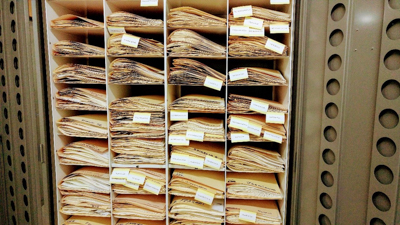What is a herbarium?
"A herbarium is a collection of preserved plants stored, cataloged, and arranged systematically for study by professionals and amateurs from many walks of life. A collection like this is a vital reference when you need to identify a plant and also serves to fix forever the identity of thousands of plant names. A herbarium is a cross between a museum of priceless artifacts and a warehouse of birth certificates for plants; and acts as a source of information about plants - where they are found, what chemicals they have in them, when they flower, what they look like. Preserved plant specimens can be used to provide samples of DNA and to validate scientific observations. A herbarium is therefore of immense practical use and of fundamental importance to science.
Individual plants or parts of plants are preserved in various ways, stored and cared for over time so that current and future generations can identify plants, study biodiversity and use the collection in support of conservation, ecology and sustainable development. The curator of a herbarium is responsible for its long-term care, maintenance and development. Many of the plants in the Kew Herbarium were collected hundreds of years ago and have priceless significance for botanical science as well as being an important resource for ecologists, scientists, geographers and historians.
Herbaria that organize their specimens systematically, by family, genus and species, serve as a working hypothesis of a classification of all plants. Specimens from related species are found close to one another thus facilitating their comparison."
- Kew Botanic Gardens, http://apps.kew.org/herbcat/gotoWhatIsHerbarium.do

Workflow Process
The following is the series of processes that result in the addition of new specimens to the collection. From the collecting of a plant in the wild, to the filing of the specimen into our main collection- this is the workflow of our herbarium. Resources on specific protocols are included.
Collection
Usually plants brought into the herbarium have been collected in a plant press and are adequately dried. The plants are stored in newspaper until mounted onto herbarium paper.
Collecting plants in the field should follow appropriate protocols, such as ensuring adequate and quality plant material, and recording detailed location information. For protocols, see resources below.
Collection and Field Preparation of Specimens- UNC Herbarium
http://herbarium.unc.edu/chpt18.html
Field Techniques Guide by the Missouri Botanical Garden
http://www.mobot.org/MOBOT/molib/fieldtechbook/welcome.shtml
Collecting Guide by the University of Western Ontario
http://www.uwo.ca/biology/pdf/research/collectingguide.pdf
Collecting Geographic Data in the Field
http://www.flmnh.ufl.edu/herbarium/methods/Georeferencingbestpractices.htm
Mounting
Mounting is the process of attaching the plant material to paper for preservation. Typically the plant is glued to the paper to show adequate detail of the plant. Standard procedure includes displaying front and back sides of leaves, as well as attaching small fruits or seeds in an envelope. These details enable future researchers to evaluate the morphological traits associated with its' taxonomy.
University of Florida mounting guide:
https://www.flmnh.ufl.edu/herbarium/methods/mountingguide.htm
Annotation
Annotation refers to the verification of the identity of the specimen. If the ID is unknown, expertise is sought for verification. A trained botanist will use a taxonomic key to deduce the species based on morphological characters.
The ASU herbarium uses the Flora of the Southern and Mid-Atlantic States by Alan Weakley for current nomenclature and taxonomic status. This valuable resource is available online as a free pdf here:
http://herbarium.unc.edu/FloraArchives/WeakleyFlora_2015-05-29.pdf
http://ipni.org/ -the International Plant Names Index, a database of current nomenclature
Annotation Recommendations by the University of Florida
http://www.flmnh.ufl.edu/herbarium/anno/
Labeling
Labels are created and attached to each specimen, containing information on the species, collector, locality, and habitat.
Label Information by the University of Florida
https://www.flmnh.ufl.edu/herbarium/voucher.htm#Labels
Accessioning
An accession book is kept in the herbarium for recording each new addition to the collection. An accession number is recorded and given to each specimen.
Imaging
High-resolution images are made of each specimen in our photo room, which are then uploaded onto the SERNEC portal: http://sernecportal.org/portal/
SERNEC is a searchable database containing imaged specimens from 230 herbaria in 14 states.
Workflows:
- Image Station Setup Camera
- Image Station Setup Lightbox
- Image Capture Protocol
- Image Processing For SERNEC
- Image Workflow Overview
Filing
Once the specimen is imaged, it is filed in the appropriate location within the main collection. The collection is organized into angiosperms, gymnosperms, seedless vascular plants, bryophytes, and fungi. Within each group, specimens are further organized alphabetically by taxonomic family. For plants, each family contains multiple folders of genera.
Workflows:
Digitization & Transcription
Completed vouchers must be uploaded, georeferenced,and transcribed.
Workflows:
- Uploading Images- Cyberduck vs iDrop Overview
- iDrop Instructions
- Cyberduck Instructions
- Symbiota Skeletal Data Entry
- SERNEC Crowdsourced Data Entry By Joe McKenna
For Herbarium Curators
Workflows:
- SERNEC N.F.N Expedition Instructions
- Linking Notes From Nature records to Symbiota
- Using GEOLocate within Symbiota by Lisa Wallace
- Symbiota / GEOLocate CoGe Instrunctions DRAFT
- Darwin Core Archive (DwC-A) data publishing
Alternative Workflows:
Arkansas
Georgia
Kentucky
Tools
- Create your own virtual herbarium - Utah Valley State Herbarium
- Monitoring Temperature and Relative Humidity
More Resources
Guide to the Natural Communities of North Carolina, 4th Approximation
http://cvs.bio.unc.edu/pubs/4thApproximationGuideFinalMarch2012.pdf
NCU Flora of the Southeast Atlas
http://www.herbarium.unc.edu/seflora/firstviewer.htm
World Flora Online
"The World Flora Online consortium (WFO) was established to systematize collaboration between plant-science institutions towards sharing research holdings and developing the infrastructure necessary to build a comprehensive online database--providing scholarly and colloquial names and synonyms, authoritative images, peer-reviewed descriptions, specimen lists and geographic distributions, conservation assessments, gene sequences, and more, for all known plant species on earth--and make it all publicly accessible."
http://sweetgum.nybg.org/science/world-flora/
Illustrated Glossary of Botanical Terms and Terminology by Dr. Albert E. Radford
http://www.ibiblio.org/botnet/glossary/vasc.html
UNC Herbarium Botany Resources
http://herbarium.unc.edu/botlinks.htm
Digitization Workflows for Flat Sheets and Packets of Plants, Algae, and Fungi